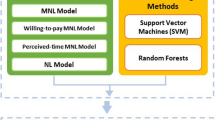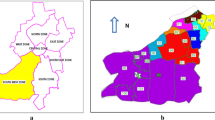Abstract
Increased intercity travel and consequent freeway congestion have made intercity transportation a big concern for planners and decision makers. Common rail-based solutions require high capital costs, and most existing modes face trade-offs between mobility and accessibility. An alternate solution could be High Speed Bus Transit (HSBT), an innovative intercity transit service proposed by the authors, that has high cruising speed on a freeway-dedicated lane and multiple terminals in the urban area. This paper is focused on modeling the mode choice behavior of individuals and identifying the significant factors influencing people’s choice of intercity travel mode. Furthermore, the feasibility and potential market of the proposed HSBT is also studied in competition with other intercity travel options such as drive, rail, regular bus and a demand-responsive shuttle service. To collect the data, an interactive stated preference survey was employed that estimates the respondent-specific attribute values in a real-time manner, customized to the individual information provided by the respondents. Such a process helps to present a choice set that reflects each individual’s travel context more realistically. The collected data showed that a transportation option with the characteristics of HSBT, that provides a fast, reliable, accessible, frequent and safe intercity travel, has the potential to take up a considerable market share, even larger than driving. Having applied a discrete choice model, the significant factors influencing the choice preference were recognized and the analysis results provided insightful findings toward intercity mode choice behavior and improving intercity transit services.


Similar content being viewed by others
References
Basu D, Hunt JD (2012) Valuing of attributes influencing the attractiveness of suburban train service in Mumbai city: a stated preference approach. Trans Res A: Policy Pract 46(9):1465–1476
Bates J (1982) Stated preference technique for the analysis of transportation behavior. In: Proceedings of world conference of transportation research, Hamburg, pp 252–265
Ben-Akiva M, Lerman SR (1985) Discrete choice analysis: theory and application to travel demand. MIT Press, Cambridge
Ben-Akiva M, Morikawa T (2002) Comparing ridership attraction of rail and bus. Trans Policy 9(2):107–116
Ben-Akiva M, Morikawa T, Shiroishi F (1992) Analysis of the reliability of preference ranking data. J Bus Res 24(2):149–164
Beyond Traffic: 2045 Final Report (2017) US Department of Transportation
Collins EM (2013) The curbside bus industry: a new era of bus travel. Master Thesis, University of Delaware
Correia GA, Viegas JM (2011) Carpooling and carpool clubs: clarifying concepts and assessing value enhancement possibilities through a stated preference web survey in Lisbon, Portugal. Trans Res A: Policy Pract 45(2):81–90
Creemers L, Cools M, Tormans H, Lateur PJ, Janssens D, Wets G (2012) Identifying the determinants of light rail mode choice for medium- and long-distance trips. Trans Res Rec: J Trans Res Board 2275(1):30–38
Edwards M, Mackett RL (1996) Developing new urban public transport systems: an irrational decision-making process. Trans Policy 3(4):225–239
Getting there greener-The guide to your lower-carbon vacation (2008) Union of Concerned Scientists. UCS Publications, Cambridge
Givoni M, Rietveld P (2007) The access journey to the railway station and its role in passengers’ satisfaction with rail travel. Trans Policy 14(5):357–365
Hensher DA, Waters WG (1994) Light rail and bus priority systems: choice or blind commitment? Res Trans Econ 3:139–162
Hensher DA, Li Z, Mulley C (2014) Drivers of bus rapid transit systems—influences on patronage and service frequency. Res Trans Econ 48:159–165
Hensher DA, Mulley C, Rose JM (2015) Understanding the relationship between voting preferences for public transport and perceptions and preferences for bus rapid transit versus light rail. J Trans Econ Policy 49(2):236–260
Hine J, Scott J (2000) Seamless, accessible travel: users’ views of the public transport journey and interchange. Trans Policy 7(3):217–226
Hole AR (2004) Forecasting the demand for an employee park and ride service using commuters’ stated choices. Trans Policy 11(4):355–362
Koppelman FS, Bhat C (2006) A self instructing course in mode choice modeling: multinomial and nested logit models. US Department of Transportation, Federal Transit Administration, Washington
Louviere JJ (1988) Analyzing decision making: metric conjoint analysis. Sage Publications Inc., Newbury Park
Louviere JJ, Hensher DA, Swait JD (2000) Stated choice methods: analysis and applications. Cambridge University Press, Cambridge
Mackett RL, Edwards M (1998) The impact of new urban public transport systems: will the expectations be met? Trans Res A: Policy Pract 32(4):231–245
Maricopa Association of Government (MAG) Commuter rail strategic plan (2008) URS Corporation, Phoenix, AZ
Meyer MD, Miller EJ (2001) Urban transportation planning: a decision-oriented approach. McGraw-Hill, New York
Outwater ML, Spitz G, Lobb J, Campbell M, Sana B, Pendyala R, Woodford W (2011) Characteristics of premium transit services that affect mode choice: TCRP H-37 summary of phase 1. Transportation 38(4):605–623
Passenger Rail Corridor Study: Tucson to Phoenix—Shaping the vision (2014) Arizona Department of Transportation
Passenger Rail Study: Tucson to Phoenix (2015) Arizona Department of Transportation. http://azdot.gov/planning/CurrentStudies/PassengerRail. Accessed May 2015
Ranjbari A, Chiu YC, Hickman M (2016) Flexpress: a flexible and express intercity transit service. In: Proceedings of ASCE international conference on transportation and development, Houston, pp 513–524
Rietveld P (2000) The accessibility of railway stations: the role of the bicycle in The Netherlands. Trans Res D: Trans Environ 5(1):71–75
Schneider J, Dutzik T, Unrein S, DE Brown (2012) Connecting Phoenix and Tucson: the benefits of intercity rail in the sun corridor. Frontier Group & Arizona PIRG Education Fund, Phoenix
Schwieterman JP, Fischer L (2010) The intercity bus: America’s fastest growing transportation mode—2010 update on scheduled bus service. Chaddick Institute for Metropolitan Development, DePaul University, Chicago
Schwieterman JP, Antolin B, Kohls J et al (2014) Motoring into the mainstream: intercity bus service in the United States—2013 year-in-review. Chaddick Institute for Metropolitan Development, DePaul University, Chicago
Shiftan Y, Vary D, Geyer D (2006) Demand for park shuttle services: a stated-preference approach. J Trans Geogr 14(1):52–59
Superbus Project (2014) http://superbusproject.com. Accessed July 2014
Vuchic VR (1991) Point of view: urban rail transit systems—recognizing the value of rail transit. Trans Res News 156:13–19
Vuchic VR, Stanger RM (1973) Lindenwold rail line and Shirley busway: a comparison. Highw Res Rec 459:13–28
Woldeamanuel M (2012) Evaluating the competitiveness of intercity buses in terms of sustainability indicators. J Public Trans 15(3):77–96
Worldwide W, CandN FJ (2000) TCRP Report 63: enhancing the visibility and image of transit in the United States and Canada. Transit Cooperative Research Program, Transportation Research Board. National Academy Press, Washington
Yannes CD, Lownes NE, Garrick NW, Johnston RJ (2010) Operationalizing place making in a choice experiment context. Trans Res Rec: J Trans Res Board 2144(1):121–129
Acknowledgements
The authors would like to thank the University of Arizona ATLAS (Advanced Traffic and Logistics Algorithms and Systems) research center for funding support. We are also grateful to the University of Arizona and Arizona State University students who helped with the data collection process and made this research possible.
Author information
Authors and Affiliations
Corresponding author
Rights and permissions
About this article
Cite this article
Ranjbari, A., Chiu, YC. & Hickman, M. Exploring factors affecting demand for possible future intercity transit options. Public Transp 9, 463–481 (2017). https://doi.org/10.1007/s12469-017-0161-3
Accepted:
Published:
Issue Date:
DOI: https://doi.org/10.1007/s12469-017-0161-3




